SWOT Analysis is a widely popular technique to examine your strengths, weaknesses, opportunities, and threats. It could be implemented to a project, proposal, or organization to asses the reliability and compatibility for making the informed decisions.
If you’re a business or an organization, you’re likely to come across the point where you need to use SWOT Analysis. It’s an incredibly useful technique to find out the strengths and weaknesses of a certain idea or plan. Whereas, this technique also helps cover the opportunities and threats that could occur during or after the specific decision making.
- Planning to shif to a new office building?
- Driving your company in a new direction?
- Launching a new product?
- Starting to work remotely?
There are a million occasions where you need to asses the situation and make choices — this analysis method can help you see the bigger picture. When you sit down and do a SWOT analysis of any situation that requires your attention, you get to see through it. The reason is that you find out the possible upside and downside of the situation before opting to go forward.
Let’s dive deep and find out why to do SWOT Analysis in the first place.
Why You Should Do SWOT Analysis
SWOT Analysis is a strategy of closely examining the prospective plan or ponder on the challenges.
When an organization decides to do a SWOT Analysis, it intends to scrutinize the ideas, processes, and capabilities to control and improve the outcome.
The methods, however, could be different depending upon the requirements or industry, but the concept remains the same, which is figuring out the strengths, highlighting the weaknesses, finding the opportunities, and understanding the threats.
To do so, there is no restriction on the team who does that examination. Therefore, some companies design a taskforce from all the departments and give them a task to examine the prospective plan and give their report.
Most of them give their taskforce a specific period to analyze and study the case, then it followed by the report submission or voting to grasp the findings. Some organizations also hire experts to do so.
Moreover, early-stage startups go to evangelists and mentors to help and put forward their ideas in front of them so that they could learn another point of view. Following are the reasons why you should do a SWOT Analysis:
To Find the Popular Opinion
When organizations or companies build a task force, the job of the task force is to analyze the idea based on the organization’s strengths, weaknesses, opportunities, and threats.
Later on, the team member submit individual reports or they poll in the favor or against the idea. So organizations learn the popular opinion about their proposal or ideas through a SWOT analysis.
To Analyze the Experts’ Views
One of the major reasons why SWOT analysis is popular among startups and businesses is that you can get experts’ opinions and get to learn from them.
Startups often work with evangelists who brainstorm the ideas and sit down with the entrepreneurs to discuss the minimum viable product, scaling the business, target audience, product capability, consumer
To Get the Perspective from a Different Lens
It’s also possible that a company would try out SWOT analysis to asses the situation or a probability of an outcome.
They could do this to judge the perspective of others. As said before, the SWOT analysis could be done by the representatives of each department or by the outsiders. The purpose could be to see what others’ think about the concept or idea.
Understanding Strengths, Weaknesses, Opportunities, and Threats
Let’s briefly look at these concepts before going towards the SWOT analysis templates:
>> Strengths
Strength is an ability to perform a job better than others based on the capability, passion, or interest of the respective person. Similarly, the organizations or departments also have their strengths to operate in a specific situation better than others because of their expertise or relevance.
The reason strengths are worth identifying and discussing is that once they’re identified and truly utilized, they can turn the table around. Organizations that find their strengths see positive implications of the ideas that could result in more productivity, profitability, and exposure.
Strengths are determined based on awarenss, information, and experience. For instance, if a men’s fashion brand has various products and they need to understand their strength, all they need is to answer the following questions:
- What’s your best-selling product?
- What competitive advantage do you have on competition?
- When does the sales graph go up during the year?
- What’s the most profitable marketing channel for their company?
- Why do the customers prefer their brand over the competition?
The idea of understanding your strengths leads to motivation, better performance, and increased output. Once a person or a brand comprehends this inside power, it becomes easier to translate the targets into reality.
The fundamental reason why many businesses do SWOT analysis is that they want to know what the future holds for their product or idea before they go all in. Therefore, understanding your strength is a big deal.
>> Weaknesses
A weakness is an identification of the area that requires some attention or could inflict negative results if it’s not taken care of beforehand. In SWOT analysis connotation, weakness is a similar idea. It identifies the lacking part of the process that needs immediate inspection.
The realization of any organization or project’s weaknesses has its perks. It alerts the team right off the bat that what could go wrong or what requires some extra care. Therefore, the weaknesses section gives us insights into our projects for a better understanding of what could go wrong so that:
- We could get prepared for the challenge
- We could put more effort into dealing with the situation
- We also look out for the alternatives
- We know our direction once things don’t work out
- We don’t waste time on the pity party and get to work
So finding the weaknesses and figuring out the solutions is a massive responsibility, which wouldn’t have been possible without a system in place. Therefore, SWOT analysis helps us get through this.
>> Opportunities
An opportunity is a situation that could bring positive changes to the business or organization. The opportunities require good judgment, a lot of experience in the space, and professional exposure to explore and make the most of it.
Opportunities don’t come so easily. As a matter of fact, the risk-factor is always involved in the opportunities that could cause failures, but they’re worth trying. The SWOT analysis, however, sheds some lights on the risk too. You’ll learn about those risks in the threats-section.
The reason that makes such opportunities so glittery is that they’re linked to a fascinating outcome.
For example, let’s assume that a mobile manufacturing company tries to enter a new market where the competitors haven’t entered yet, it comes with an opportunity to dominate the space, but the risk-factor can’t be ignored. There might be a reason why no competitors entered that market yet.
The mobile manufacturing company must look at the following factors:
- What’s the inflation rate in the country as compared to neighboring countries?
- How is the purchasing power of the consumer in the country?
- What mobile manufacturing companies are already there?
- How is the telecom industry doing in the country?
- What’s the status of 3G/4G data services in the country?
- What’s the total number of current mobile phone users in the country?
Once they know all the data through research, they’d be able to conclude whether or not entering that new market is an opportunity.
>> Threats
A threat is an alarming signal that tells you what could possibly go wrong and result in putting you or the organization in a tough spot. It’s extremely important to go through all the challenges before taking a step forward in any venture.
Threats are those challenging probabilities that could hurt the course of any plan. Therefore, a SWOT analysis is often done to cope with all the upcoming challenges.
For example, if you’re starting a bridal clothing company that designs bridal dresses in Los Angeles.
Moreover, you want to use e-commerce to enter the market. And, you also want to target the audience through an online search for organic traffic to your website. Once you’ve established all that, you may want to look into the following details:
- What other bridal dress designers are doing business in LA?
- What’s the price range of a bridal dress in the market?
- What’s their marketing strategy for selling the dresses?
- Are they doing local SEO for selling dresses online?
- What keywords are they using to dominate the local Google search?
Once you go through all these details and find out that the competitors have already been doing local SEO, and they’re dominating the relevant keywords, then it’s a huge threat to your whole marketing strategy.
Doing the SWOT analysis would enable you to learn all such details so that either you could alter your keywords strategy or choose a different marketing course for reaching to the audience.
10 SWOT Analysis Templates
1. SWOT Competitor Analysis Template
This SWOT Analysis template is a simple competitor analysis chart that gives you a layout to analyze multiple competitors. It’s available in Excel format, which means you can make changes if you want to. It helps you analyze your competitors side by side so that you could go through the details based on your information. You can download the template by clicking here.
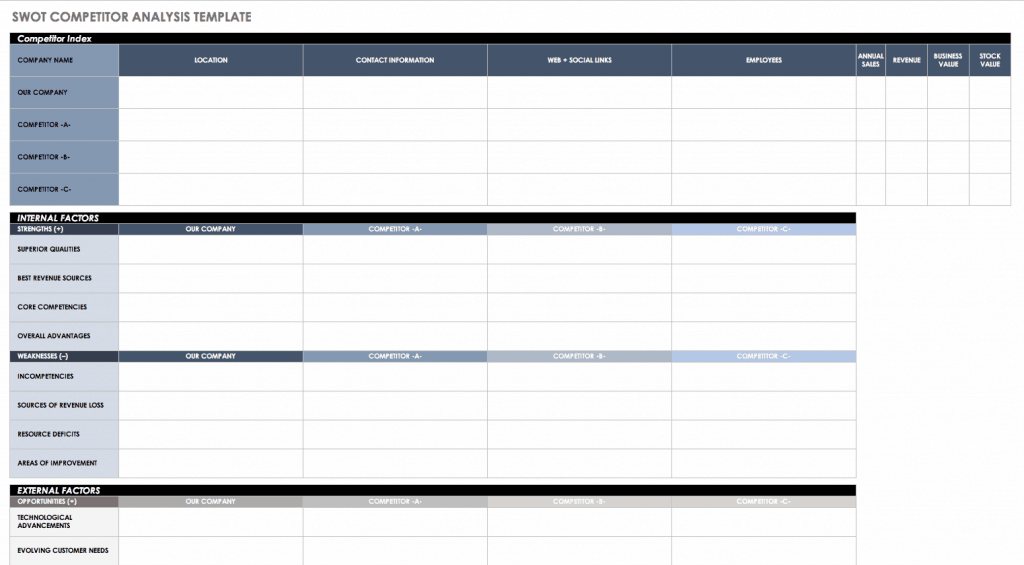
2. Single Competitor Template
This template helps you focus on a single competitor so that you could lazor focus on the competition in detail. There are various types of templates available out there so you’d have to know what you want to analyze. Comparing your organization to a single competitor means you could sift through and compare both the brands from the head to toe. This SWOT template is available in PowerPoint file; click here to download.
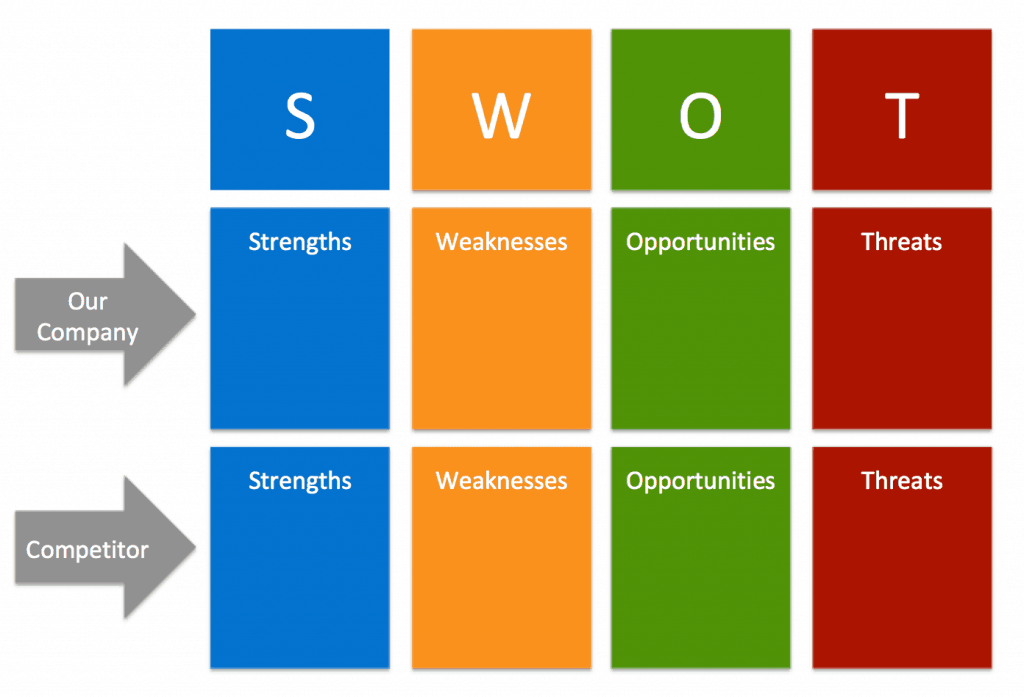
IMG: 2-competitors-swot-template-powerpoint
3. SWOT Analysis Strategy Template
This template infuses the strategy-part into the mix, but for the most part, it has pretty much the same internal factors such as strengths and weaknesses and external factors like opportunities and threats. The internal factors are highlighted on the x-axis and the external factors are on the y-axis. Download this template.
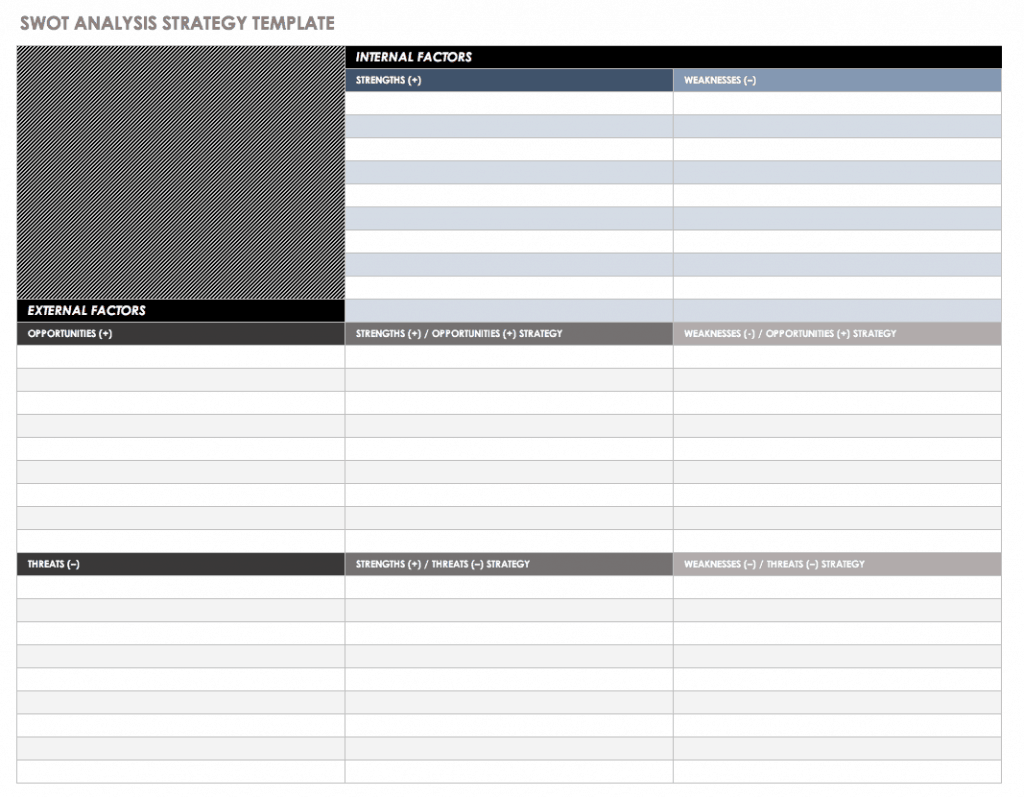
4. SWOT Matrix Template
This is one of the simplest SWOT templates on the list. It got a simple format that emphasizes the correlation between the factors, for example, the internal factors are mentioned in the first row and the external factors in the second row.
Moreover, both these factors are highlighted in distinctive colors to differentiate them. This template is available in PowerPoint format. Download this template.
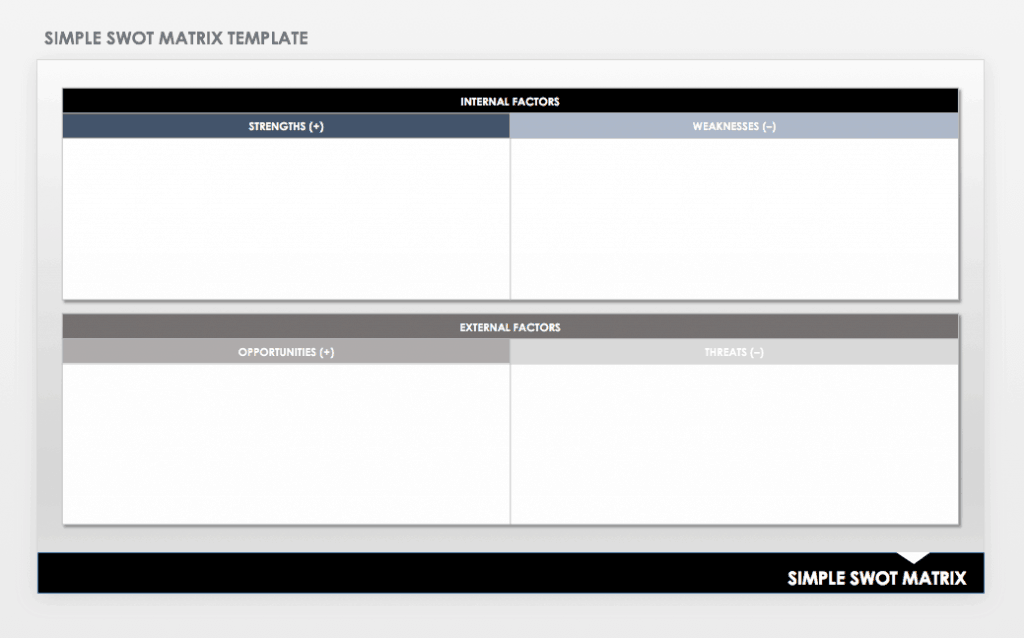
5. SWOT Puzzle Template
This template offers a unique puzzle-style PowerPoint slides which allow users to put in the text in all four parts of the SWOT analysis template. There is plenty of room for text to fit in and help process the information.
It could also show how strengths, weaknesses, opportunities, and threats are interconnected to each other. Download this PPT template by clicking here.
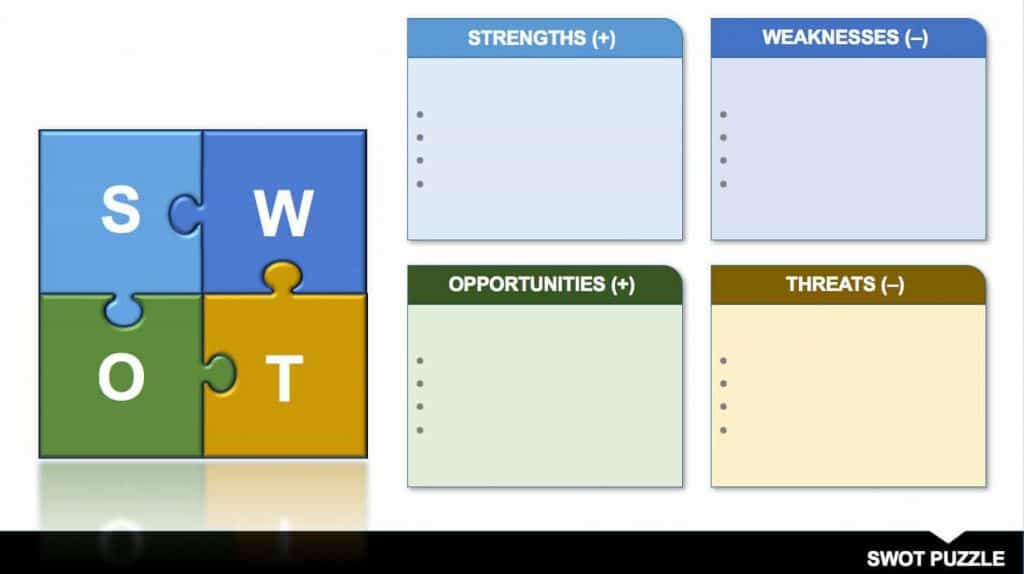
6. Diamond SWOT Analysis Template
This SWOT analysis template puts the four categories into a diamond shape element. All the categories are differentiated through separate colors to ensure that the audience grasps the information easily.
It provides you with a unique layout consisting of internal and external factors displayed side-by-side.
All four sections have the text areas to add write-ups. The format of this SWOT analysis template is PPT. Download it by clicking here.
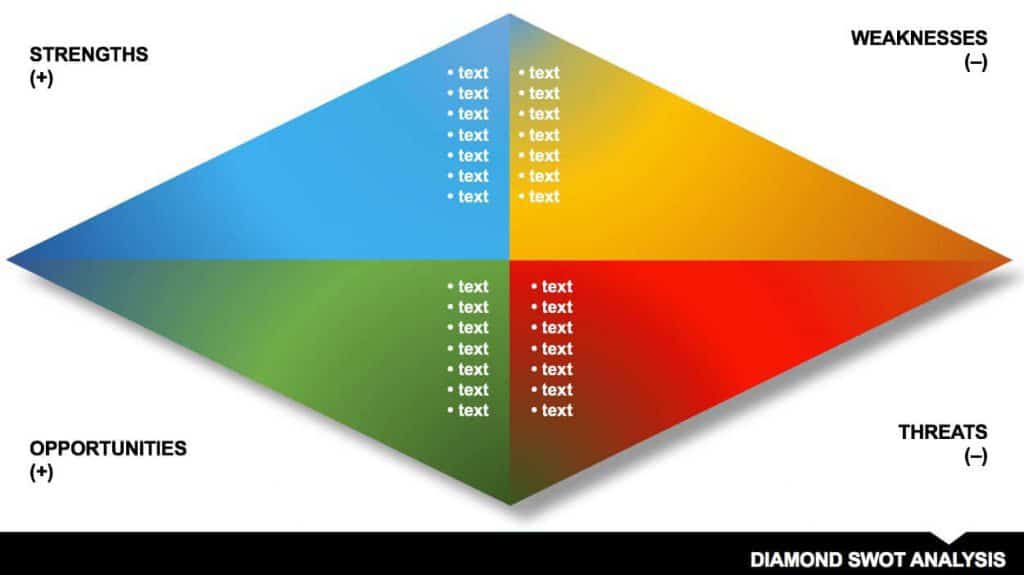
7. Simple Matrix Analysis
Simple Matrix template is a four-quadrant table consisting of four key elements of SWOT analysis. Each section could be highlighted in a unique color-coded grid to give it a distinctive look.
Simple Matrix Analysis template is available in Excel format. Download this simple template from here.
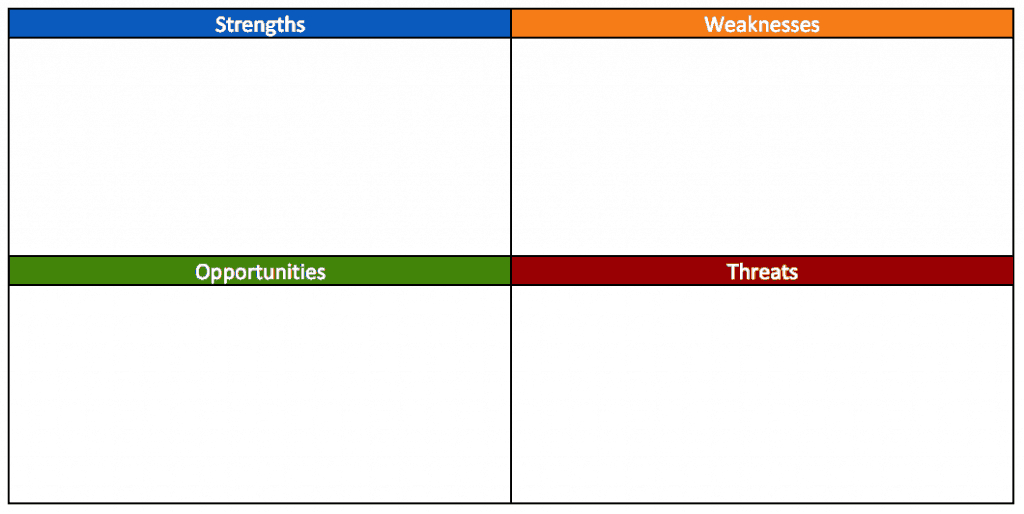
8. Business Planning Template
It’s a typical business project analysis template that could help a team pen down the strengths, weaknesses, opportunities, and threats before starting a project or after the completion.
Both the internal and external sections have a summary box to write down the analysis.
This template could help businesses oversee the projects or the outcomes of a new project. Such information and analysis reports often help define the organization’s course. Download this template.
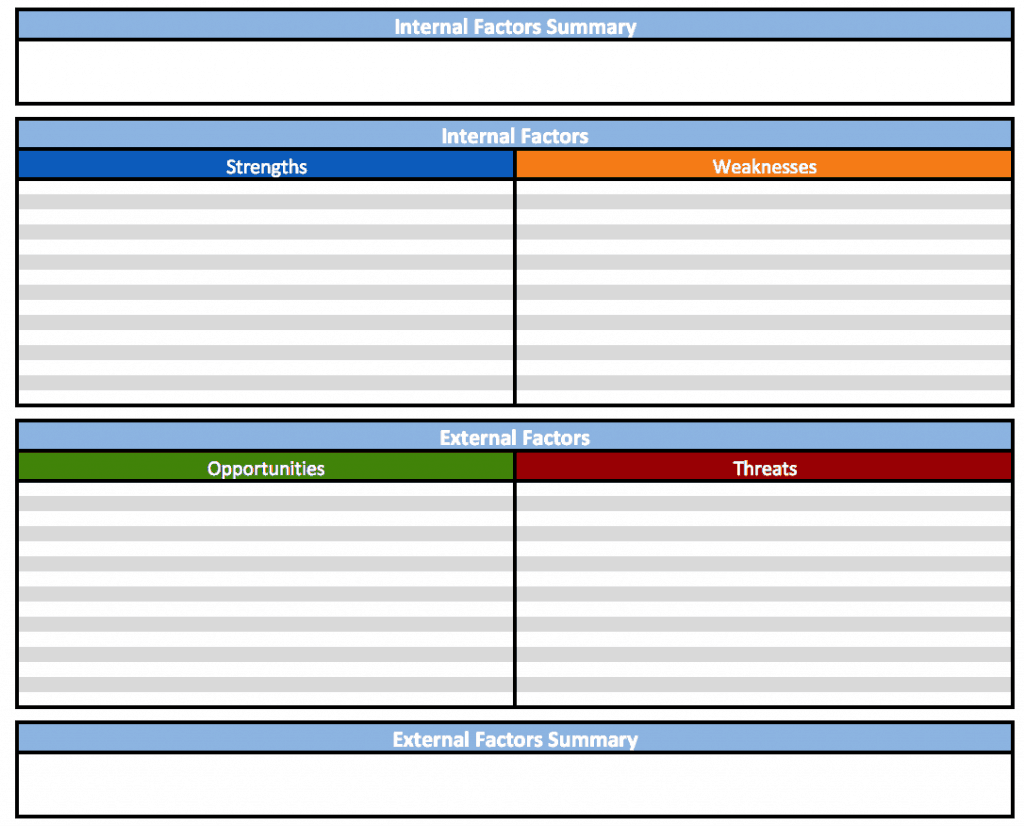
9. Top-down Template
Top-down Template is one of the simplest templates as it allows you to focus on one element at a time.
It has all four components mentioned from top to bottom, which could be expanded as per requirement.
The idea behind a top-down template is that we could put one thing under the spotlight and give full attention to that before moving to the next. This template could help us focus on a proposal or idea with a microscopic view.
The top-down template is available in excel format. Download from here.
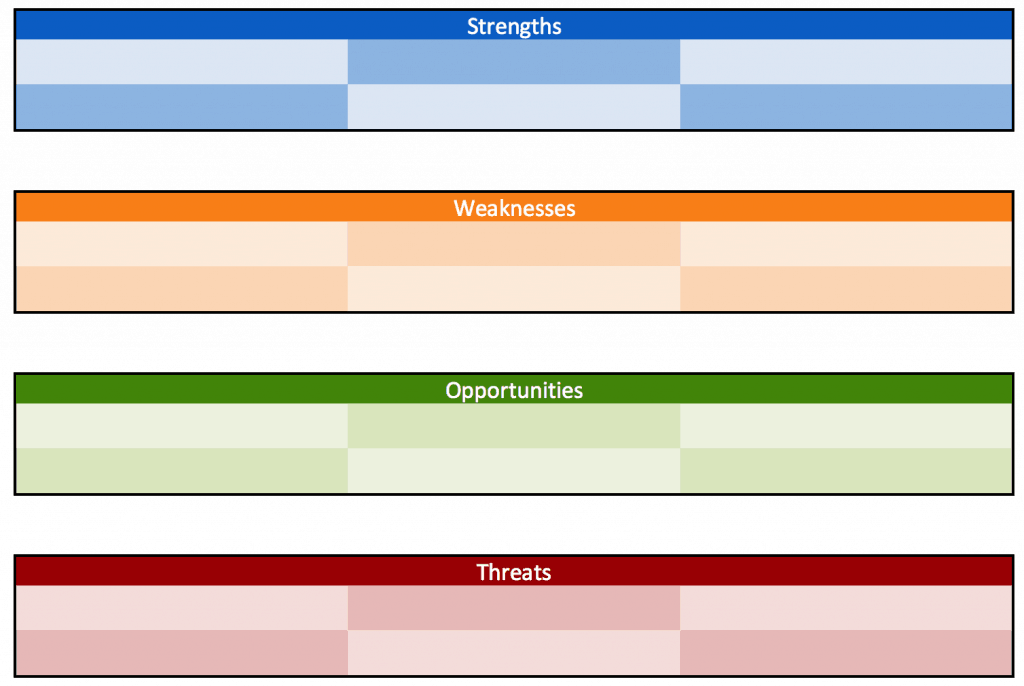
10. Personal SWOT Analysis
This is a type of SWOT analysis that you need for setting personal goals, analyzing inner strengths, maximizing your productivity, or making career decisions.
This is more of a personal examination to understand yourself and eliminate the waste from your thought-processes such as self-doubts, pitty, and others’ opinions — almost anything that’s holding you back.
The personal SWOT analysis template has a simple layout with internal factors such as strengths and weaknesses on top and external factors such as opportunities and threats below the internal factors. Download
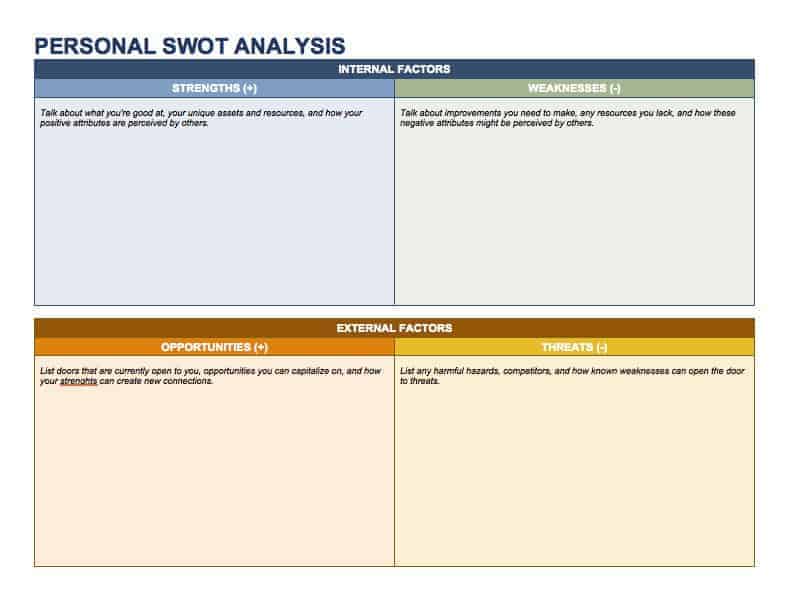
Final Thoughts?
A SWOT analysis is an easy-to-perform analysis activity that you can do whether you’re a 3-member startup company or you’re running a large organization with hundreds of employees.
The purpose behind this blog post was articulate the what power SWOT analysis holds when it comes to diving deep and understanding the circumstances.
It might as well improve your decision making, uncover new possibilities, and understand others’ opinions. One of the upsides of the SWOT analysis is that it either involves other team members to give their opinions or it puts the idea in front of everyone — either way, it shapes the ideas into better forms.
What have you learned so far about SWOT analysis?
Share with us in the comments section.



